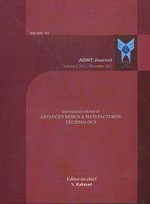Improvement Analysis of Response Between Jacket Platforms and Sea Waves using the Vibration Dampers
Subject Areas : vibration and control
Latif Pendarian
1
,
Alireza Fiouz
2
*
![]() ,
Abbas Gasemi
3
,
Abbas Gasemi
3
1 - Department of Civil Engineering, Central Tehran Branch, Islamic Azad University, Tehran, Iran
2 - Department of Civil Engineering, Persian Gulf University, Bushehr, Iran
3 - Department of Civil Engineering, Central Tehran Branch, Islamic Azad University, Tehran, Iran
Keywords: initial conditions, inertial forces, Liquid damper with rectangular tank, Eulerian, fluid solution field, Navier-Stokes equations,
Abstract :
Offshore fixed metal platforms have unique characteristics in specific location such as shallow waters, and oil platform may be physically connected to seabed. Offshore platforms in the sea are affected by complex and destructive forces caused by wind, waves, marine currents, earthquakes and even large displacement vortex forces. The purpose of refurbishing metal fixed platforms is to somehow equalize the capacity of the structure with its seismic requirements. In some cases, they increase the capacity of the structure to meet seismic requirements. In this research, dynamic vibration absorbers or dampers, such as passive dampers, fluid system adjusted for damping vibrations and reduced structural response against wave and earthquake hydrodynamic loads will be used as an efficient control method. The purpose of this research is to improve the performance of the liquid platform vibration damping of the metal platform. The results show that equipping offshore platforms with liquid damping systems has a good performance on the safety and dynamic behaviour of the platforms and has a significant effect on the displacement response and acceleration of the platform under study at its highest deck level. Also, as the water depth in the tank increases, the damping value for the rectangular and cylindrical tanks decreases and the rectangular tank creates more control and damping force than the cylindrical tank.

